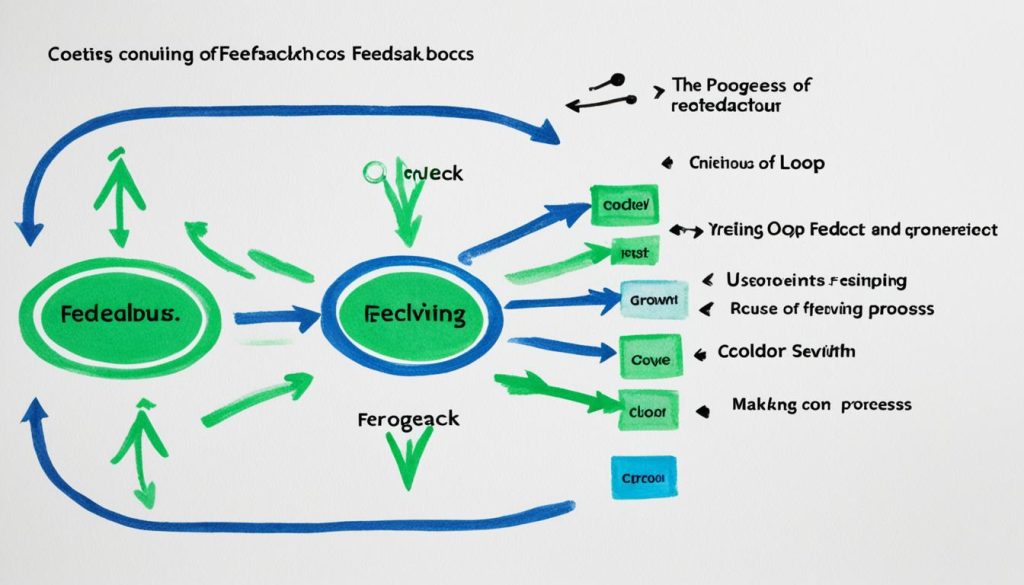Have you ever gotten negative feedback that made you feel down, defensive, or unsure of what to say? You’re not the only one. Dealing with criticism can be tough, but what if we told you that negative feedback is actually a gift in disguise? A recent study found that 90% of the most successful entrepreneurs say negative feedback helped them grow and succeed. By adopting a growth mindset and using smart strategies, you can turn criticism into a chance for personal and professional growth.
This guide will show you how to handle negative feedback with grace and turn tough situations into positive talks. It doesn’t matter if you’re a business owner, content creator, or employee. Learning how to respond to criticism can help you cultivate a positive online presence, protect your brand reputation, and foster a respectful community. Plus, it can unlock your full potential for growth and success.
Why Negative Feedback Is Actually Positive
Feedback, whether it’s good or bad, is key to growing personally and making a team succeed. Gallup’s data shows a strong link between getting “meaningful feedback” from your boss and how engaged employees feel. Those who say they got a lot of feedback last week are almost four times more likely to be engaged than those who didn’t.
Negative feedback is like a mirror showing you what you can’t see on your own. It highlights areas where you can get better at your job. This value of negative feedback is in showing you things you might have missed or didn’t think were important. Learning to value constructive criticism can really help you grow and improve at work.
Understanding how negative feedback helps you grow can turn it into a chance to get better. It lets you work on your skills and how you do things. Remember, both good and bad feedback is key to getting better and reaching your goals.
| Key Benefit | Impact on Performance |
|---|---|
| Insight into blind spots | Helps identify areas for improvement |
| Constructive criticism | Contributes to personal growth and professional development |
| Catalyst for continuous improvement | Enables you to reach your full potential |
Adopt a Growth Mindset
Handling negative feedback well is key. Having a growth mindset is vital. See negative feedback as a chance to learn and grow. Keep a positive attitude towards constructive criticism. This change of view turns feedback into a powerful tool for growth.
Feedback, whether good or bad, gives you insights. It shows where you can get better and reach your goals. By seeing feedback as a gift, you open up to ongoing learning and growth. This way, you don’t see it as a personal attack.
Embrace Feedback with Enthusiasm
Take negative feedback with a positive and open-minded attitude. Don’t get defensive or feel down. See it as a chance to learn new things and improve your skills. This shows you’re emotionally smart and mature. It also helps you build a good reputation, strengthen relationships, and move forward in your career.
- See negative feedback as a chance to grow and improve.
- Cultivate a positive attitude towards constructive criticism.
- Understand that feedback is a valuable tool for learning and development.
A growth mindset is key to turning challenges into opportunities. It helps you see negative feedback as a way to success.
Actively Listen
When you get negative feedback, it’s key to listen well. Don’t interrupt and focus on what the person is saying. Showing you care and want to understand helps make a safe space for sharing.
This way of talking helps you really get what the feedback means. You can use it to get better at what you do. Listening well shows you’re open to learning and growing. This can make your relationships and work place better.
- Avoid interrupting the feedback provider and give them your full attention.
- Demonstrate your understanding by rephrasing or summarizing the key points.
- Ask clarifying questions to ensure you have a clear grasp of the feedback.
- Acknowledge the feedback provider’s perspective and express your appreciation for their insights.
Using active listening with negative feedback can help you grow. It lets you learn new things and creates a place where people can talk openly and helpfully.
Pause and Reflect
When you get feedback, especially if it’s negative, don’t act on impulse. Take a moment to think before you respond. This thoughtful pause lets you carefully evaluate the feedback’s validity and relevance to your goals and values.
By taking time to respond to feedback, you show you’re open to growing and willing to improve. This pause stops you from avoiding defensive reactions that can make the feedback less helpful.
Evaluate the Feedback
During this pause, evaluate the feedback you’ve received. Think about how it fits with your goals and points out areas to get better. Consider the specific advice it gives and how you can use it to grow personally and professionally.
- Check if the feedback is valid by looking at the source and the situation it came from.
- See if the feedback is relevant to your goals and the task you’re doing.
- Find the areas where the feedback says you can get better.
This thoughtful way of handling feedback helps you answer in a positive way. It shows you’re serious about continuous improvement thanks to the valuable feedback you’ve received.

Seek Clarification
When you get negative feedback, it’s key to seek clarification for personal growth. Ask questions and seek specific examples to understand the feedback better. This shows you’re ready to fix problems and open to helpful advice.
Asking for more details shows you’re open to feedback and want to use it well. It helps you find the main causes of issues, making it simpler to make changes. This way, you and the person giving feedback can work together better.
- Ask for specific examples to show the problems.
- Find out the context of the feedback for a full view.
- Clear up any unclear points to prevent mistakes.
- Talk back and forth to really understand the feedback.
By seeking clarification and asking for examples, you turn negative feedback into a chance to grow. This shows you’re serious about getting better and ready to learn from others.
Express Gratitude
When you get negative feedback, it’s key to show real thanks to the person giving it. Expressing gratitude shows you care about their thoughts and are open to feedback. Saying thanks makes a positive vibe that fosters positive communication and builds trust with the person giving feedback.
Doing this makes your work relationships stronger. It also lets you learn a lot from different views. When you say thanks, you show you’re ready to learn and get better. This can really help you grow in your life and work.
- Thanking someone for their feedback means you value their time and hard work.
- Recognizing the worth of their advice shows you’re serious about getting better.
- Keeping a positive and team-focused attitude makes it safe for others to share their thoughts.
By expressing gratitude, you open the door for honest and helpful talks. These talks can lead to big changes and foster positive communication. This also helps to build trust with your coworkers, bosses, or clients.
Remember, negative feedback is a chance to grow. By taking it well with a positive attitude, you can turn it into a big help for your personal and work growth.
Separate Self Worth From Feedback
Handling negative feedback means keeping your self-worth separate from what others say. Remember, negative feedback doesn’t define who you are. It’s about specific actions that could be better.
It’s key to keep a strong self-image when facing criticism. Don’t take feedback personally to protect your confidence. See it as a way to grow, not a hit on your worth.
Embrace Feedback as an Opportunity
When you get negative feedback, think of it as a chance to get better. It’s not a personal attack. It’s a way to spot areas for improvement. Be open and curious about how you can use this feedback.
- Separate your sense of self-worth from the feedback you receive
- Maintain a healthy self-image by avoiding personalization of criticism
- Embrace negative feedback as an opportunity for growth and improvement
Remember, negative feedback is about specific actions, not your whole self. This helps you not let it bring you down. With this mindset, you can turn criticism into a positive force for growth.
| Approach | Description |
|---|---|
| Personalize Feedback | View negative feedback as a reflection of your overall worth as an individual |
| Separate Self-Worth | Understand that feedback addresses specific behaviors, not your inherent value |
Set Actionable Goals
Handling negative feedback is key to getting better. By setting actionable goals, you can use criticism to grow. Start by analyzing the feedback to see what needs work. Then, set clear goals to track your progress.
Turning feedback into steps you can take helps you improve. This way, you can fix your weaknesses and drive continuous improvement. It makes you feel focused and purposeful in your work. Remember, negative feedback is a chance to get better and achieve more.
- Analyze the feedback to identify specific areas for improvement
- Set measurable, actionable goals to address the identified weaknesses
- Break down your goals into smaller, manageable steps
- Regularly track your progress and adjust your goals as needed
- Celebrate your achievements and milestones along the way

By using this strategy, negative feedback can help you improve and succeed. Stay focused and committed to your goals. Watch as you overcome challenges and grow.
Seek Support and Guidance
When you face negative feedback, it’s key to seek support and guidance from trusted people. Talking to mentors, colleagues, or supervisors can give you great advice. This can help you deal with constructive criticism better. By collaborating for growth, you create a place where feedback helps you get better.
Trusted advisors can give you good advice. They help you see things from different angles and turn feedback into a chance to improve. Remember, asking for help shows you’re serious about getting better, not weak.
- Find mentors, colleagues, or supervisors who can give you honest and helpful feedback.
- Talk openly to seeking support and understand the feedback better.
- Work with your support group to make a plan to improve.
- Keep an open mind and be ready to gain different perspectives to grow personally and professionally.
By using the power of seeking support and collaborating for growth, you can turn negative feedback into a chance to learn and get better. Be around people who can guide you, encourage you, and offer new ideas to help you achieve more.
| Benefit | Description |
|---|---|
| Seeking support | Reach out to mentors, colleagues, or supervisors to gain valuable perspectives and insights on handling negative feedback. |
| Gaining different perspectives | Engage in open discussions to explore alternative viewpoints and develop a well-rounded understanding of the feedback. |
| Collaborating for growth | Work together with your support network to create an action plan for personal and professional improvement. |
Implement a Feedback Loop
Improving yourself and your work is key. One great way is by talking often with your boss or team. This helps everyone grow by sharing feedback.
Getting and giving feedback helps everyone work better together. It makes work smoother and builds strong bonds. By using the feedback loop, you can get better at what you do and make work better for everyone.
- Regularly ask for feedback from your boss or team.
- Talk openly about how you’re doing and what you can do better.
- Listen well to what others say and ask questions to understand better.
- Make a plan to get better and stick to it.
- Thank people for their feedback. It helps you do a better job.
A feedback loop is about sharing and learning from each other. By being open and eager to learn, you open up new chances for growth.

| Benefits of a Feedback Loop | Strategies to Implement a Feedback Loop |
|---|---|
|
|
Celebrate Progress
As you work on personal and professional growth, remember to celebrate your progress, even if it’s small. Acknowledging your wins is a great way to stay motivated. It also helps keep a positive mindset that drives your success.
When you accept negative feedback as a chance to get better, it’s key to celebrate your small wins. This keeps your motivation up and helps you stay positive about your growth.
Recognize Your Accomplishments
Make it a habit to look back and celebrate your wins, no matter how small. It could be learning a new skill, beating a challenge, or just keeping up with your efforts. Take time to say thanks for these wins. It boosts your confidence and motivates you to aim higher.
- Celebrate hitting a milestone or reaching a goal, even if it’s a small one.
- Notice the small wins, like finishing a task or moving forward on a big project.
- See how you bounce back from setbacks and learn from them.
Reward Yourself
It’s also key to reward yourself for your hard work and commitment. This could be enjoying a favorite snack, taking a break, or doing something you love. Rewarding yourself links your efforts to feeling good about your achievements.
- Have a small celebration, like a special meal or time with friends, for a big win.
- Try a hobby or activity you’ve been wanting to do.
- Buy a tool or resource that helps you grow personally or professionally.
Having a positive mindset and celebrating your progress are vital for keeping up your motivation. They help you stay on track towards growth and success.
Handling negative feedback on blogs
Getting negative feedback can be tough, especially for bloggers who work hard to keep their readers happy. But, seeing it as a chance to get better can really help. By listening well, asking for more details, and responding thoughtfully, you can make criticism work for you. This can make your blog better and help you connect with your readers.
Embrace Negative Feedback with a Growth Mindset
When you get negative feedback, it’s key to stay open and ready to change. Negative feedback often gives you great insights on what you can do better. See it as a way to learn and improve, not a personal attack.
Actively Listen and Seek Clarification
Make sure to really understand the negative feedback you get. Actively listen to what your readers say and ask for more details if you’re not sure. This shows you care about their opinions and want to make your community stronger.
Implement Strategies to Turn Criticism into Opportunities
- Find specific steps you can take to fix the issues mentioned in the feedback.
- Try out new types of content, topics, or ways to connect with your readers.
- Always ask for feedback to keep up with what your readers like and don’t like.
By seeing negative feedback as a chance to grow, listening well, and making smart changes, you can turn criticism into a way to get better. This helps you build a stronger, more connected community around your blog.

8 Ways to Get Feedback From Employees
Getting feedback from employees is key to a feedback-driven culture and better communication. By using different methods, you can learn a lot, fix problems, and make your team more engaged and productive. Here are eight good ways to get feedback from your employees:
Regular One-on-One Meetings
Have regular one-on-one meetings with your employees. This lets them share their thoughts, worries, and ideas freely. These meetings are great for getting feedback and understanding what your team needs and faces.
Anonymous Surveys
Do anonymous surveys to let employees give honest feedback safely. This way, you can learn about your company’s culture, work environment, and what needs to get better.
Focus Groups
Set up focus groups to get deeper insights on certain issues or concerns. Open-ended conversations in these groups can reveal valuable feedback and possible solutions.
Suggestion Boxes
Use physical or digital suggestion boxes for employees to share their ideas and feedback without revealing their names. This is a good way to hear from those who might not speak up in a group.
Pulse Surveys
Do pulse surveys often to check how employees feel and get feedback on different parts of your organization. These quick surveys help you keep up with your team’s changing needs.
Open-Door Policies
Create a culture of openness and approachability with an open-door policy. This means employees feel free to talk to you or other leaders about their feedback and concerns.
Exit Interviews
Do exit interviews with leaving employees to learn about their experiences, find out what needs to improve, and know how to keep and engage your team better.
Feedback-Driven Culture
Always work on a culture that values feedback and talking. Encourage employees to share their views, listen well, and show that their input is important for your organization’s growth.
Using these methods to get feedback from employees helps you learn a lot, makes your team more engaged and productive, and leads to ongoing improvement in your organization.
Turning Challenges into Opportunities
Getting negative feedback can feel tough, but it’s key to see its value for your growth. By adopting a mindset that sees challenges as chances to get better, you can turn criticism into a boost for success.
Embracing Challenges with a Positive Attitude
When you face negative feedback, it’s important to see challenges as ways to get better. Transforming criticism into opportunities means being open to driving personal and professional growth. This comes from reflecting on yourself and being ready to embrace challenges.
Listening to feedback, asking for more details, and taking time to think can reveal what you need to work on. This helps you set goals and keep improving, making sure you’re always growing.
- Cultivate a growth mindset: See negative feedback as a chance to learn and get better, not a personal hit.
- Actively listen and seek clarification: Ask questions to understand the feedback better and its importance.
- Implement a feedback loop: Always look for feedback, check on your progress, and celebrate your wins.
Handling negative feedback well not only helps you grow but also makes the workplace better. By embracing challenges and turning criticism into opportunities, you’ll reach your full potential and keep growing in your career and life.

| Approach | Impact |
|---|---|
| Viewing negative feedback as a learning opportunity | Encourages a growth mindset and personal development |
| Actively seeking feedback and implementing it | Results in ongoing improvement and professional growth |
| Maintaining a positive and open attitude | Builds a team that supports and works together |
Foster a Positive Work Environment
Handling negative feedback well can greatly improve your work culture. By making sure constructive criticism is welcome, you promote open talk and constant betterment. This approach helps your team reach their best potential and achieve lasting success.
When your team feels free to give and take feedback in a kind and growth-focused way, it boosts teamwork, engagement, and job happiness. A positive workplace where everyone aims for growth makes people feel they belong and trust each other more.
A positive work culture relies on open, honest, and helpful feedback. Use negative feedback as a chance to get better, improve processes, and make a place where everyone feels important and supported in striving for excellence.

